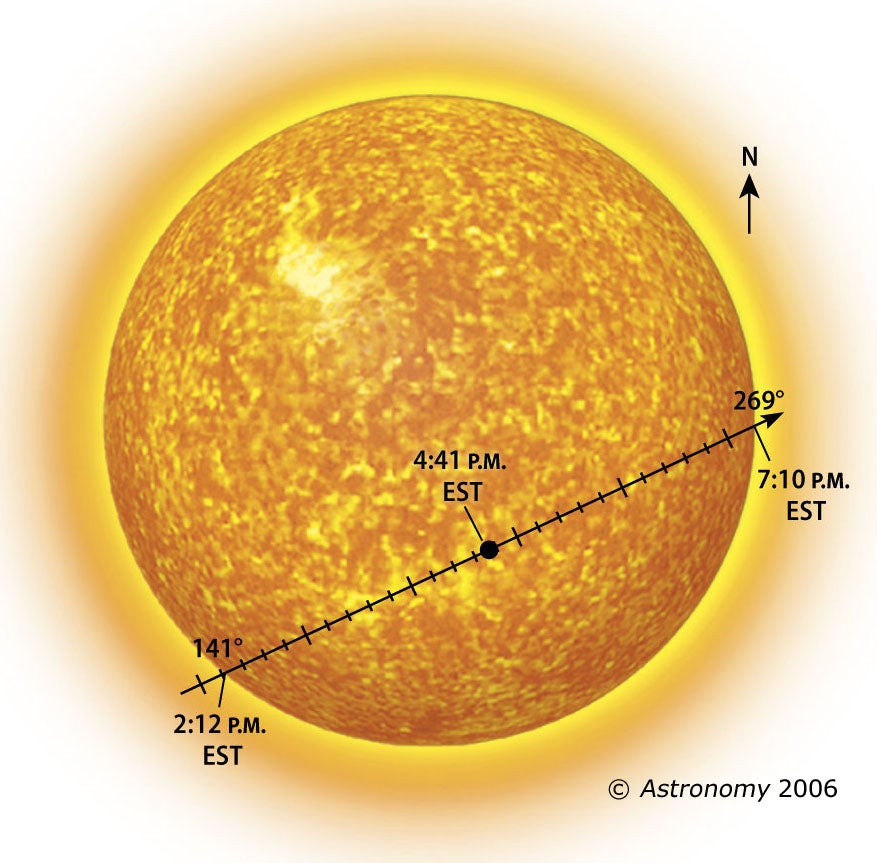
More Astronomy resources:
Astronomy news
This week’s sky events
Astronomy basics
Glossary of astronomical terms
Return to Astronomy “For the media” page
When to watch
Mercury begins its journey across the Sun at 2:12 p.m. EST. Astronomers call this moment “first contact.” Two minutes later, Mercury’s entire disk appears against the Sun’s (second contact). For the next 4 hours and 54 minutes, the black dot slowly crosses the brilliant disk. Mid-transit occurs at 4:41 p.m. EST. At that moment, Mercury lies closest to the Sun’s center – 7’03” away. At 7:08 p.m. EST, Mercury reaches the Sun’s edge, marking third contact. The transit ends (fourth contact) 2 minutes later.
Observers under clear skies across North America will be able to see portions of the event before sunset, but the entire transit will be visible for those near the West Coast.
November 2, 2006
Waukesha, WI – Next Wednesday afternoon, the planet Mercury will be visible in silhouette as it slides across the Sun’s face. This event, called a transit, lasts about 5 hours as Mercury, which orbits the Sun in just 88 days, passes Earth.
People with Internet access can watch the event from their computers thanks to a few live webcasts. Links to the live webcasts are listed below.
Advanced observers will watch the planetary shadow play through telescopes and safe solar-viewing equipment and techniques. A properly filtered telescope will provide the best view, because Mercury will appear only 1/194 the size of the Sun. The planet will look like a small, dark sunspot as it moves across the solar surface. Even a brief glimpse of the Sun through a telescope can permanently damage vision, so observers must use safe Sun-viewing equipment and techniques.
Experts at your disposal
Astronomy magazine editors are available to discuss this event. To request an interview, please contact Matt Quandt at 262.798.6484 or mquandt@kalmbach.com.
Astronomy‘s mission
Astronomy promotes the science and hobby of astronomy through high-quality publications that engage, inform, entertain, and inspire.
Rare passage
Seen from Earth, only the planets Mercury and Venus can transit the Sun. Mercury transits occur about 13 times each century. Venus transits occur in pairs eight years apart, but a recurring pattern of either 105.5 or 121.5 years between the last transit of one pair and the first transit of the next pair is the general rule. We’re now in a prime period for observing these events.
Mercury last transited the Sun in May 2003; Venus last did so in June 2004. After November 8, Venus will be the next planet to cross the Sun, in June 2012. Mercury follows suit 4 years later, in 2016.
Transit zones
Why are Mercury transits so rare? Mercury’s orbit is tipped with respect to Earth’s and crosses the plane of our orbit at only two points. For a transit to occur, Mercury must lie near one of those points when it passes us. To meet these conditions, Mercury must slip between Earth and Sun within 3 days of May 8 or within 5 days of November 10.
The unequal size of these “transit zones” reflects the eccentricity of Mercury’s orbit, which gives us twice as many transits in November as in May. Mercury lies farther from the Sun and moves much slower in May, which reduces our chance of catching it in the right place. But Mercury’s disk appears 20-percent larger during May transits because it’s closer to us then.
Transit history
Transit observations provided scientists with the first glimpse of the solar system’s vast scale. Seventeenth-century astronomer Johannes Kepler was the first to predict Mercury and Venus transits. He noticed that each would transit the Sun in 1631 and encouraged other astronomers to observe them. Kepler died before his predictions were fulfilled.
On November 7, 1631, French astronomer Pierre Gassendi watched the Mercury transit from his Paris apartment. He used a telescope to project a magnified image of the Sun’s disk onto a paper screen in a darkened room. About 5 hours before Kepler’s prediction, Gassendi saw something between clouds that looked like a very small sunspot. Could this tiny black dot – merely 1/200 the Sun’s apparent diameter – be the planet? Mercury’s gradual progress across the solar disk removed all doubt.
“The crafty god had sought to deceive astronomers by passing over the Sun a little earlier than was expected,” Gassendi wrote. “I found him out, and saw him where no one else had hitherto seen him.”









